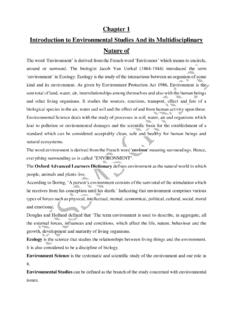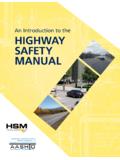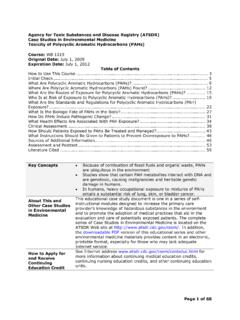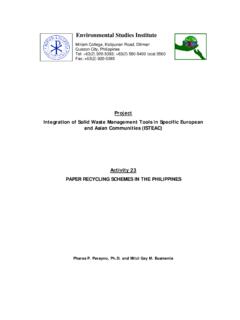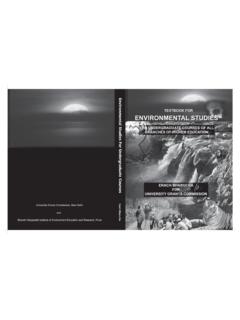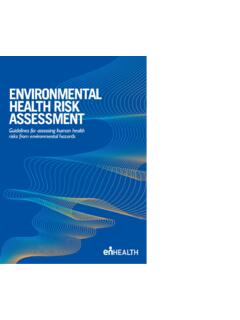Transcription of Guideline on the environmental riak assessment of ...
1 European Medicines Agency Pre-Authorisation Evaluation of Medicines for Human Use 7 Westferry Circus, Canary Wharf, London E14 4HB, UK Tel. (44-20) 74 18 84 00 Fax (44-20) 74 18 8613 E-mail: EMEA 2006 Reproduction and/or distribution of this document is authorised for non commercial purposes only provided the EMEA is acknowledged London, 01 June 2006 Doc. Ref. EMEA/CHMP/SWP/4447/00 corr 21* COMMITTEE FOR MEDICINAL PRODUCTS FOR HUMAN USE (CHMP) Guideline ON THE environmental RISK assessment OF MEDICINAL PRODUCTS FOR HUMAN USE DISCUSSION IN THE SAFETY WORKING PARTY Jun 1999 -Nov 2000 TRANSMISSION TO THE CPMP January 2001 RELEASE FOR CONSULTATION January 2001 DEADLINE FOR COMMENTS July 2001 DISCUSSION IN THE SAFETY WORKING PARTY Oct 2002 - June 2003 TRANSMISSION TO THE CPMP June 2003 RE-RELEASE FOR CONSULTATION July 2003 DEADLINE FOR COMMENTS January 2004 DISCUSSION IN THE SAFETY WORKING PARTY Feb 2004 Nov 2004 TRANSMISSION TO THE CHMP January 2005 RE-RELEASE FOR CONSULTATION January 2005 DEADLINE FOR COMMENTS April 2005 AGREED BY SAFETY WORKING PARTY May 2006 ADOPTION
2 BY CHMP 01 June 2006 DATE FOR COMING INTO EFFECT 01 December 2006 1 Section 2, paragraph 5, removes the ambiguity of the word exempt which was meant to refer to the content of the ERA dossier and not to the legal requirement for an ERA dossier. Section 8, paragraph 2, addition of the word studies after ERA to clarify similarly that the Guideline refers to the absence of ERA studies , not to the absence of the ERA dossier itself (expert report as a minimum). CPMP/SWP/4447/00 Corr 2 2/12 EMEA 2006 Guideline ON THE environmental RISK assessment OF MEDICINAL PRODUCTS FOR HUMAN USE TABLE OF CONTENTS TABLE OF CONTENTS.
3 2 EXECUTIVE SUMMARY .. 3 1 INTRODUCTION .. 3 2 SCOPE AND LEGAL BASIS .. 3 3 GENERAL PRINCIPLES .. 4 4 PHASE I: ESTIMATION OF EXPOSURE .. 4 SCREENING FOR PERSISTENCE, BIOACCUMULATION AND TOXICITY .. 4 CALCULATION OF THE PREDICTED environmental CONCENTRATION (PEC) .. 4 ACTION LIMITS .. 5 5 PHASE II: environmental FATE AND EFFECTS ANALYSIS .. 5 TIER A: INITIAL environmental FATE AND EFFECTS ANALYSIS .. 6 OUTCOME OF TIER A FATE AND EFFECTS ANALYSIS .. 7 TIER B: EXTENDED environmental FATE AND EFFECTS ANALYSIS .. 7 OUTCOME OF TIER B FATE AND EFFECTS ANALYSIS .. 9 6 PRECAUTIONARY AND SAFETY MEASURES TO BE TAKEN FOR ADMINISTRATION, DISPOSAL AND LABELLING.
4 9 7 SCIENTIFIC ADVICE FROM THE CHMP .. 10 8 THE environmental RISK assessment REPORT .. 10 9 NOTE .. 11 10 LIST OF 11 11 ANNEX .. 12 CPMP/SWP/4447/00 3/12 EMEA 2006 EXECUTIVE SUMMARY The purpose of this Guideline is to describe the assessment of potential environmental risks of human medicinal products. It specifies the scope and legal basis for assessment . It outlines general considerations and the recommended step-wise procedure of assessment . The general outline of the environmental Risk assessment Report is given, and, when risks cannot be excluded, this Guideline outlines precautionary and safety measures to be considered.
5 1 INTRODUCTION An environmental Risk assessment (ERA) shall accompany an application for a marketing authorisation for a medicinal product for human use. This Guideline describes how to evaluate potential risks of the medicinal product to the environment. The Guideline also includes considerations for potential precautionary and safety measures to be taken, and recommendations for the environmental Risk assessment Report. 2 SCOPE AND LEGAL BASIS In accordance with Article 8(3) of Directive 2001/83/EC, as amended, the evaluation of the potential environmental risks posed by medicinal products should be submitted, their environmental impact should be assessed and, on a case-by-case basis, specific arrangements to limit the impact should be considered.
6 In any event this impact should not constitute a criterion for refusal of a marketing authorisation. An environmental risk assessment (ERA) is required for all new marketing authorisation applications for a medicinal product through a centralised, mutual recognition, decentralised or national procedure. For type II variations, the evaluation of the environmental impact should be made if there is an increase in the environmental exposure, a new indication may result in a significant increase in the extent of the use. For extension applications according to Annex II of Commission Regulation (EC) No 1085/2003, an environmental risk assessment is also required if there is a potential increase in the environmental exposure, an extension application of an oral medicinal product to include a dermal patch.
7 An ERA is not required for renewals or Type IA/IB variations. In the case of products containing vitamins, electrolytes, amino acids, peptides, proteins, carbohydrates and lipids as active pharmaceutical ingredient(s), an ERA should be provided. This ERA may consist of a justification for not submitting ERA studies , due to their nature they are unlikely to result in a significant risk to the environment. The same applies to vaccines and herbal medicinal products In all cases, except for Type I variations and renewal applications, an environmental risk assessment or a justification for its absence should be provided in Module of the Marketing Authorisation Application (MAA, see section 8).
8 Directive 2001/83/EC, as amended, relates to those risks to the environment arising from the use, storage and disposal of medicinal products and not to risks arising from the synthesis or manufacture of medicinal products. This Guideline is focused on environmental risks associated with the use of medicinal products. This Guideline does not apply to medicinal products consisting of genetically modified organisms (GMOs). Applicants are referred to the Guideline on environmental Risk assessment for Human Medicinal Products containing, or consisting of, genetically modified organisms (GMOs) (Module ).
9 (EMEA/CHMP/BWP/135148/04) For marketing authorisation applications for radio-pharmaceutical precursors for radio-labelling and radio-pharmaceuticals, additional requirements on emission standards for radiation set by Council Directives 96/29/Euratom and 97/43/Euratom should be taken into account. CPMP/SWP/4447/00 4/12 EMEA 2006 3 GENERAL PRINCIPLES assessment of the potential risks to the environment is a step-wise, phased procedure, consisting of two phases. The first phase (Phase I) estimates the exposure of the environment to the drug substance. Based on an action limit the assessment may be terminated.
10 In the second phase (Phase II), information about the fate and effects in the environment is obtained and assessed. Phase II is divided in two parts, Tier A and B (see Table I). Certain substances, such as highly lipophilic compounds and potential endocrine disruptors, may need to be addressed irrespective of the quantity released into the environment. Table 1: The phased approach in the environmental risk assessment Stage in regulatory evaluation Stage in risk assessment Objective Method TEST / DATA REQUIREMENT Phase I Pre-screening Estimation of exposure Action limit Consumption data, logKow. Phase II Tier A Screening Initial prediction of risk Risk assessment Base set aquatic toxicology and fate Phase II Tier B Extended Substance and compartment-specific refinement and risk assessment Risk assessment Extended data set on emission, fate and effects 4 PHASE I: ESTIMATION OF EXPOSURE In phase I, the estimation should be based only on the drug substance, irrespective of its route of administration, pharmaceutical form, metabolism and excretion.










